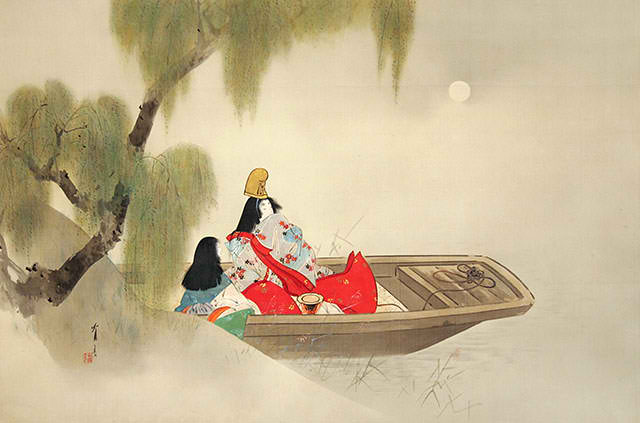
Watanabe Seitei
Japanese, 1851-1918
Shirabyoshi Dancers in Asazuma Boat, n.d.
hanging scroll; ink and color on silk
27 1/8 x 18 1/8 in.
SBMA, Museum purchase with the John and Peggy Maximus Fund
2011.26.2

Artist's Seal
COMMENTS
Shirabyoshi were traditional female court dancers who performed in male costumes. The term, shirabyoshi (lit. 'white measure markers') refers to the white face make-up they wore and the rhythmic music which accompanied the dances. Their distinctive attire included the tate-eboshi hat of a samurai, a tachi (long ceremonial sword), red hakama (pants traditionally worn only by men), white and red suikan (a male Shinto robe), and a kawahori folding fan (carried by men). Although originally associated with the Heian Period (794-1185) courts, shirabyoshi would also perform for high-ranking samurai and religious ceremonies. Similar to the highest ranking courtesans of the pleasure quarters, shirabyoshi were expected to be literate and educated in the arts. In addition to dancers they were also poets, singers, and musicians. Although they were performers by profession, their proximity to men of rank and power understandably resulted in liasons and offspring (some legendary), and as such, shirabyoshi also symbolized romantic sentiments associated with mistresses and lovers.
While shirabyoshi were not necessarily courtesans or concubines, a shirabyoshi dancer seated in a boat became a reference to Asazuma-bune prostitutes. Asazuma was a port on the eastern shore of Lake Biwa near Kyoto. Long boats that were available to cross the inlet, Asazuma-bune (lit. Asazuma boats), were also used by prostitutes who were celebrated in classical poetry. The poet Saigyo (1126-98) mentions a shirabyoshi in an Asazuma boat. By the Edo period (1600-1868), Asazuma became a name for a 'temporary wife,' while Asazuma-bune became shorthand (both verbal and visual) for 'floating' prostitutes.
Shirabyoshi in an Asazuma-bune became a popular theme in songs, dances and in ukiyo-e, often accompanied by poetry or lyrics referencing morning (asa) departures (by boat) from a 'wife' (mistress or prostitute) of the evening. The subject of this painting is based on a famous composition inspired by an older poetic theme adapted to a kouta song by the artist Hanabusa Itcho (1652-1724).
References
Tim Clark, Ukiyo-e Paintings in the British Museum, 1992, p. 168, no. 119 (for comparison with a painting of the same subject by Teisai Hokuba)
- Watanabe (Shotei) Seitei, Shirabyoshi Dancer in an Asazuma-Bune, Scholten Japanese Art, 145 West 58th Street, New York
http://www.scholten-japanese-art.com/monogatari_12.htm
SBMA CURATORIAL LABELS
Best known as a bird-and-flower painter, Seitei depicted landscapes as well as figures. He was also a brilliant illustrator and designer of textiles and cloisonné in Tokyo. He was thefirst Japanese artist to study abroad in Europe (Paris 1878-81) and among the first Meiji artists to have his work collected in the West as well as an early proponent of the "nihanga" movement., "Japanese-style painting," as opposed to Western-style painting. This painting exemplifies the best of Seirei's paintings in its unique blend of the traditional subject matter and medium with new artistic expressions - elegant brushwork, refined washes, startling colors against dreamlike surroundings - befittingly conveys a subject of beauty and poetic lament.
When this painting was executed, the traditional subject of female entertainers in a boat had acquired multiple meanings. Among them, it would have been understood as depicting a fallen prostitute who legendarily worked from boats off the shores of Asazuma, a town by Lake Biwa near Otsu. Shirabyōshi dancer (female dancers in male costumes who performed for nobility during the 12th century) was specifically an homage to an earlier ukiyo-e artist, Hanabusa Itchō (1652-1724) who popularized the theme in paintings and songs, alluding to social class, misfortune and entertainment. It was rumored that Itchō’s paintings and songs of Shirabyōshi dancers in Asazuma boat resulted in his exile in 1698: his subject was understood as a parody of the Shogun’s favorite concubine, thus a critique of the ruler’s overt indulgence. Hence, the subject was especially celebrated among artists as a symbol of the rebel spirit calling out corruption.
- Asian Art Reopening, 2021
